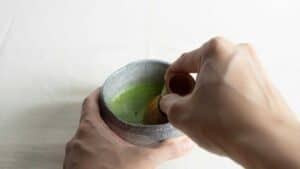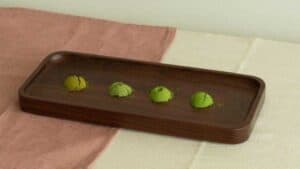
Brewing matcha requires careful attention to detail, from the production process to usage and storage. Exposure to light and air can lead to oxidation, diminishing its flavor and quality. Additionally, using the wrong water temperature can result in a bitter taste. Here are five common mistakes to avoid when brewing matcha:
1. Using the Wrong Water Temperature
A common misconception is that boiling water improves the dissolution of matcha powder. In reality, boiling water can create a bitter flavor due to matcha’s high amino acid content. For optimal taste, use water heated to 80-85 degrees Celsius. Water at 100 degrees Celsius can release excessive catechins, leading to astringency. Opt for water with a neutral pH (around pH 7) and avoid using mineral water.
2. Measuring Incorrectly
Another frequent mistake is adding too much or too little matcha powder. In Japan, the bamboo scoop known as “Chashaku” is commonly used to measure matcha. The standard method involves using 2 Chashaku scoops, equivalent to about 1 teaspoon, which is sufficient for brewing up to 6 ounces of water, yielding a rich flavor. If a lighter taste is preferred, consider brewing it as “Usucha” or Japanese thin tea.
3. Selecting the Wrong Type of Matcha
Matcha is typically categorized into two main grades: “Ceremonial” and “Culinary.” However, there are several grades of matcha powder available. It’s essential to determine the intended use of the matcha before making a selection. For instance, Ceremonial grade matcha, harvested from the first three leaves of premium tea plants in Uji, Kyoto, features an emerald green color and smooth texture, making it ideal for Usucha rather than desserts. Consult with your matcha supplier to choose the right grade for your specific needs.
4. Improper Mixing Techniques
Since matcha powder does not dissolve easily in water, simply pouring hot water over it will not suffice. Instead, use a “chasen,” a bamboo whisk, to beat the matcha until it fully dissolves before mixing it with milk or other ingredients. If milk or syrup is added prematurely, it can hinder the dissolving process. If a chasen is unavailable, a water bottle or shaker can be used to vigorously mix the ingredients, or a frother can serve as an alternative.
5. Incorrect Storage Practices
Matcha powder is sensitive and can oxidize rapidly when exposed to air, leading to a loss of flavor and aroma, as well as a fading color. To preserve its delicate taste and vibrant green hue, store matcha in a cool, dry place, away from heat, humidity, and sunlight. For long-term storage, consider refrigerating or freezing matcha, which can help maintain its freshness for up to six months. For more storage tips, visit this link.
Source:
https://tea-ceremony-kyoto.com/tea-ceremony-blog/
https://naokimatcha.com/articles/5-common-matcha-errors/





